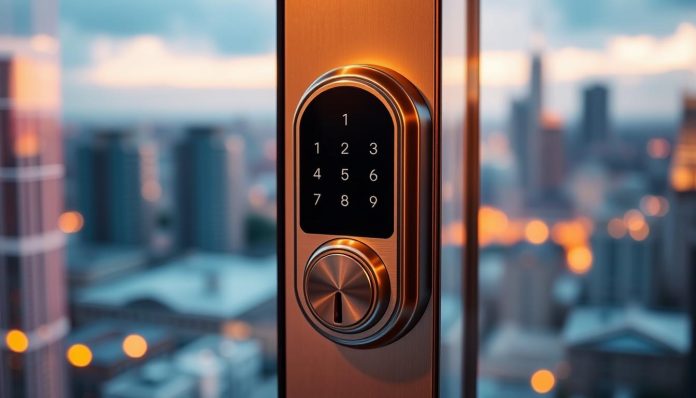You rely on a smart lock to make daily access easier and keep your home safe. This introduction gives you a clear snapshot of the 2025 landscape so you can compare what truly matters at your front door.
The field includes robust deadbolts, retrofit adapters, and lever options. Schlage, Yale, and August lead with distinct approaches: built‑in Wi‑Fi and alarms, compact multi‑platform support, and retrofit convenience that keeps your existing deadbolt.
Read on to learn practical trade‑offs: hub versus built‑in Wi‑Fi, keypad or fingerprint, and integrations like Apple Home Key or voice assistants. You’ll also get quick notes on battery life, installation, and the features that define genuine security for your door.
What “real security” means for smart locks in 2025
A truly secure smart lock starts with hardware you can trust, not just a flashy app. Begin with BHMA‑rated deadbolts and heavy‑duty metal housings that resist brute force. Physical strength matters because a weak lock invites simple, avoidable attacks.
Layered defenses are next. Look for encrypted communications, tamper alerts, auto‑lock, and activity logs that record who used a code and when. Those logs help you audit access and spot odd behavior fast.
- Built‑in alarms deter physical attacks and push instant alerts to your phone.
- Door‑status sensors verify the door is shut before the bolt engages, avoiding false confidence.
- Redundant entry paths—keypad PINs, a backup key, or mobile keys—keep you from getting locked out.
Good app controls make code management simple: schedules, one‑time codes, and quick revocation. Pair strong authentication with safe habits—unique passwords and two‑factor verification—to reduce risk.
Finally, favor reliability over novelty. Quiet, consistent operation and fast, predictable behavior are practical security features that cut user errors and keep your home safer.
How we evaluate smart locks for your home
We test each smart lock by installing it at a real front door, living with it for weeks, and running controlled tamper checks. That hands‑on method reveals practical issues that specs hide, from odd app behavior to hard‑to‑feel hardware wear.
Our goal is to give you clear, usable results so you can pick the right device for your home.
- Real‑world testing: install, daily use, and simulated tampering to spot weak points.
- Standardized rubric: we score hardware strength, software safeguards, app stability, and convenience.
- Verified fit and strength: BHMA ratings and door‑fit checks ensure the deadbolt aligns and throws under load.
- Setup and installation: we time pairing, hub vs built‑in Wi‑Fi, and firmware updates for typical DIYers.
- Integration and access: depth with Alexa, Google, and Apple, plus voice and geofencing reliability.
- Battery and alerts: measured runtime, auto‑lock impact, and clarity of logs, PIN management, and notifications.
| Criteria | What we measure | Why it matters |
|---|---|---|
| Hardware | Strength, fit, BHMA | Stops forced entry |
| Software | Encryption, app stability | Keeps remote access safe |
| Daily use | Battery, alerts, ease | Prevents lockouts and frustration |
Top Smart Locks of 2025: Schlage, Yale, August — Which Offers Real Security?
Compare flagship models to see which lock features match your daily routines and door hardware.
Quick view: each model targets a different need. One deadbolt adds built‑in Wi‑Fi and an alarm for commercial‑grade strength. Another adds Apple Home Key for frictionless entry. A retrofit module keeps your existing key while adding sensors and activity logs.
- Built‑in Wi‑Fi deadbolts favor simple remote access and fewer hubs.
- Retrofit adapters preserve your cylinder and simplify installation.
- Levers and keypad bundles serve non‑deadbolt doors or high‑traffic entries.
| Model type | Strength | Best for |
|---|---|---|
| Built‑in Wi‑Fi deadbolt | High | Remote access, minimal setup |
| Retrofit adapter | Medium | Renters, keep existing key |
| Lever / keypad bundle | Varied | Non‑deadbolt doors, many users |
Use this overview to match price, convenience, and the specific deadbolt or door you already have. That way you pick the best smart option for reliable access and solid home security.
Schlage for 2025: Encode Deadbolt and Encode WiFi Lever
Encode combines commercial-style hardware with features designed for everyday home use. The Encode deadbolt installs with a screwdriver and pairs to your home Wi‑Fi through a guided app. It includes a built‑in alarm and solid construction suited for a primary entry.
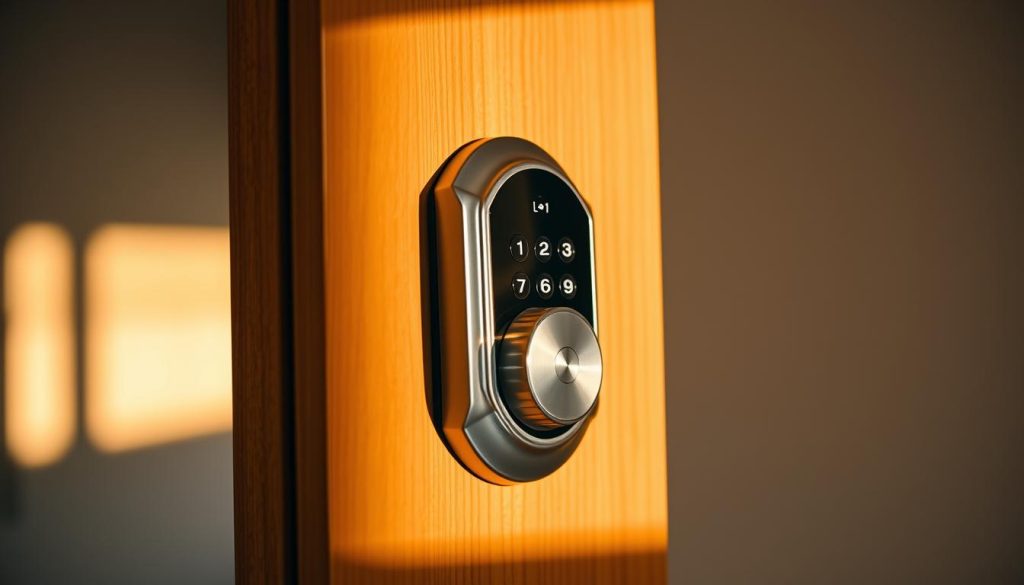
The Encode Plus variant adds Apple Home Key for fast phone and watch access. That gives you frictionless entry without touching a keypad or key.
- You can choose the Encode Deadbolt for high-grade protection with built‑in Wi‑Fi and an alarm ideal for main doors.
- You can use the Encode WiFi Lever on doors without a deadbolt and still get app control, alerts, and up to 100 codes.
- Physical lock/unlock buttons on the lever simplify daily use and enable quick passage mode when needed.
- Auto‑lock timers and clear battery alerts reduce the chance you leave a door unsecured and cut maintenance surprises.
| Model | Best for | Key features |
|---|---|---|
| Encode Deadbolt | Primary entry | Built‑in Wi‑Fi, alarm, easy install |
| Encode Plus | iPhone/Apple Watch users | Apple Home Key, same hardware |
| Encode WiFi Lever | Doors without deadbolts | Up to 100 codes, lock/unlock buttons |
You get predictable battery life and straightforward app controls for code management, notifications, and auto‑lock. That combination keeps your entry resilient and simple to operate.
Yale lineup: Assure Lock 2 and Approach retrofit with keypad
If you want quieter operation and a compact keypad, the Assure Lock 2 is worth a close look.
The Assure Lock 2 comes in several models. The base keypad is compact, all‑metal, and faster and quieter than older touchscreens. You can add an optional keyway as a mechanical failsafe when needed.
The Approach retrofit replaces the interior thumb turn to keep your exterior cylinder and keys. It pairs with the included Wi‑Fi hub for remote access and adds a wireless keypad that mounts with adhesive if you prefer a no‑drill option.
- You can use the tactile keypad outdoors to reduce mistypes and improve day‑to‑day access.
- Code management is simple: create family, guest, or contractor codes and revoke them via the app without rekeying.
- Platform support spans Alexa and Google, with specific Apple integrations on select modules.
| Model | Primary benefit | Remote control |
|---|---|---|
| Assure Lock 2 (keypad) | Compact metal build, quiet actuation | Available via app module |
| Assure Lock 2 (with keyway) | Same keypad + physical key option | App control plus mechanical backup |
| Approach + Wi‑Fi hub | Retrofit interior control, adhesive keypad | Includes hub for remote access |
August smart lock retrofit: keep your keys, add serious smarts
A retrofit adapter can give your current deadbolt modern features without changing the exterior look.
The august smart lock retrofits to the interior thumb turn so you keep your existing deadbolt and exterior keyway. Installation takes minutes and does not require removing the outside hardware. That means your curb appeal stays the same while you add app control, auto‑lock, and detailed activity history.
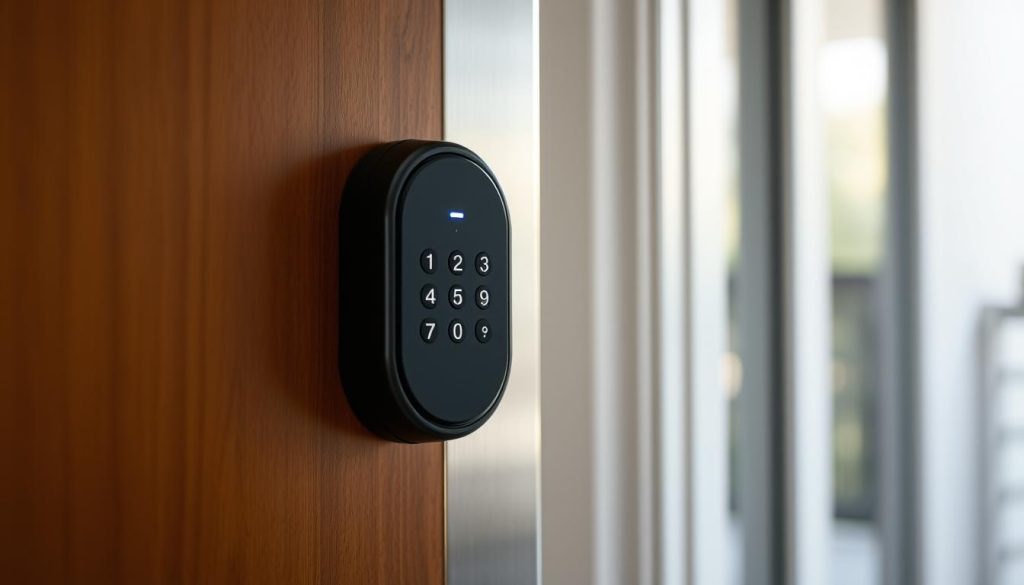
You retain your physical keys as a fallback. That helps when family or a manager needs regular entry. DoorSense verifies the door is closed before the bolt engages. This avoids false locking and reduces routine errors.
- Share timed guest passes and revoke them instantly from the app.
- Broad platform support: Alexa, Google Home, and Apple Home work with the retrofit.
- Rechargeable batteries simplify power, but expect faster drain than a full deadbolt replacement.
| Feature | Benefit | Note |
|---|---|---|
| Retrofit installation | Keep exterior look and keyway | Fits most interior thumb‑turns with adapters |
| DoorSense | Verifies closed door before locking | Prevents false secure state |
| Guest passes & activity logs | Share timed access and audit entries | Revoke codes without rekeying |
| Platform compatibility | Works with Alexa, Google, Apple Home | Matches most smart home setups |
Deadbolt replacements vs adapters vs levers: which should you choose?
Choosing the right upgrade depends on your door, daily habits, and how much hardware change you accept.
Full deadbolt replacements swap the entire lock and bring the strongest hardware and built‑in alarms. Pick this when you want maximum protection, integrated Wi‑Fi, and a clean faceplate for your main entry.
Adapter retrofits mount to the interior thumb turn so you keep the exterior key and look. They are ideal if you cannot change the outside cylinder or you prefer to keep existing keys for guests or managers.
Lever and knob replacements suit doors without a deadbolt. These give keypad entry and Wi‑Fi control while fitting traffic doors like garages or side entries.
- Installation: full swaps need precise alignment; retrofits are usually faster.
- Maintenance: built‑in Wi‑Fi drains batteries faster than Bluetooth modules.
- User experience: tactile buttons, visible tech, or minimal designs affect daily use.
| Option | Best for | Key tradeoffs | Typical install |
|---|---|---|---|
| Deadbolt replacement | Main entry, max protection | Stronger hardware, alarms | Moderate — precise fit |
| Adapter retrofit | Keep exterior key, rentals | Quick upgrade, less hardware change | Quick — interior only |
| Lever/knob replacement | Doors without deadbolt | Keypad access, generous code capacity | Easy — standard bore |
Head‑to‑head security: Schlage vs Yale vs August
When it comes to pure door protection, the differences between these brands matter more than feature lists.
You get superior physical robustness from Schlage’s Encode deadbolt, which pairs heavy hardware with a tamper alarm for high‑risk entries.
Yale’s Assure Lock 2 uses all‑metal housings and improved internals. That gives faster, quieter actuation for reliable daily use.
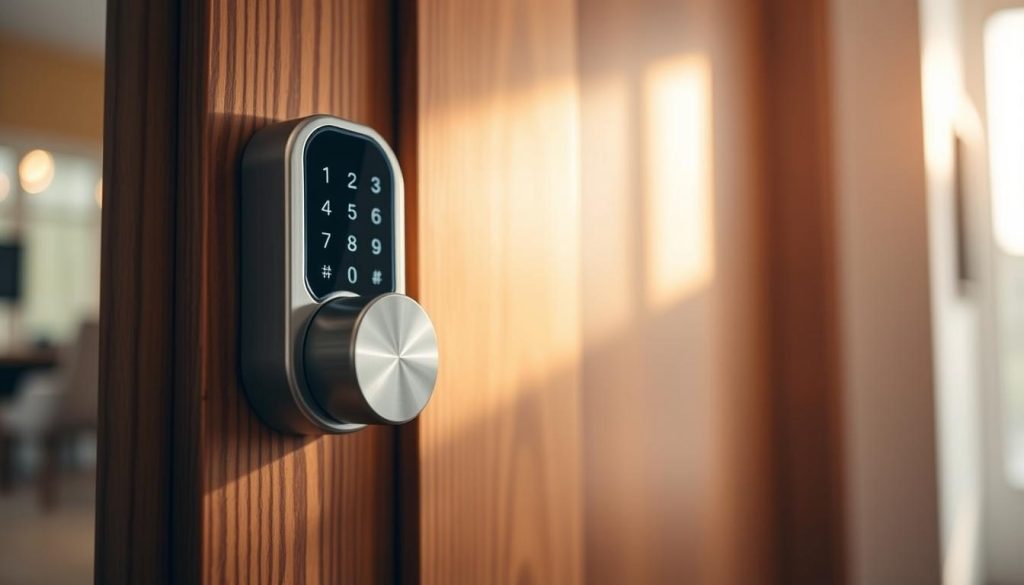
August preserves your exterior cylinder and key while adding DoorSense and modern access controls. That layered approach keeps a mechanical fallback in place.
- All three support multiple codes, auto‑lock, and activity tracking for audit trails.
- Compare response speed: how fast each lock detects and executes a command matters at the door.
- Decide if Apple Home Key (Encode Plus) or a tactile keypad (Assure) fits your routine best.
- Review alert clarity and PIN management to control who enters and when.
| Model focus | Physical build | Unique safeguard |
|---|---|---|
| Encode deadbolt | Commercial‑grade metal | Built‑in tamper alarm |
| Assure Lock 2 | All‑metal housing | Quiet, fast actuation + keypad option |
| August retrofit | Interior adapter, keeps exterior key | DoorSense verifies closed door |
Smart integrations that matter: Alexa, Google Assistant, Apple HomeKit
A well‑chosen ecosystem keeps your lock, notifications, and automations under one familiar interface.
You can standardize control in your preferred smart home app and consolidate scenes, routines, and alerts for simpler daily use.
Platform support varies by model. The Encode line connects to amazon alexa and google home, while the Encode Plus adds Apple Home Key and apple homekit ties for phone‑based keys. Many Assure models support apple homekit plus alexa and google home depending on the configuration. August and similar retrofit modules also work with amazon alexa, google home, and apple homekit.
Voice control via google assistant or alexa helps you lock when leaving, verify status, and trigger scenes that arm alarms or shut off lights. You can share digital keys through the app and limit access by day and time, then revoke them instantly when plans change.
Confirm whether you need a bridge or hub for remote access. Some locks include built‑in Wi‑Fi, while others require a hub or a Matter‑enabled bridge for wider ecosystem reach.
| Integration | Typical support | Hub/bridge note |
|---|---|---|
| amazon alexa | Encode, Assure, August | Often native; some models need a hub |
| google home / google assistant | Encode, Assure, August | Wide support; check model specifics |
| apple homekit / Apple Home Key | Encode Plus, select Assure models | Phone/wallet keys require model support |
| Matter & bridges | Level Lock Pro and hubs adding Matter | Makes cross‑ecosystem access simpler |
Matter, hubs, and remote access: what you actually need
Not every door needs an extra hub; sometimes built‑in connectivity is enough.
If you want direct remote control, pick a smart lock with built‑in Wi‑Fi so the lock talks to your router and the app without a bridge.
Retrofits and many modular options still require a hub or bridge. The Approach-style bundles include a hub, and some retrofit kits add a Wi‑Fi bridge for remote access. Devices that support Matter, like Level Lock Pro, make it easier to use multiple ecosystems and avoid repeat bridges.
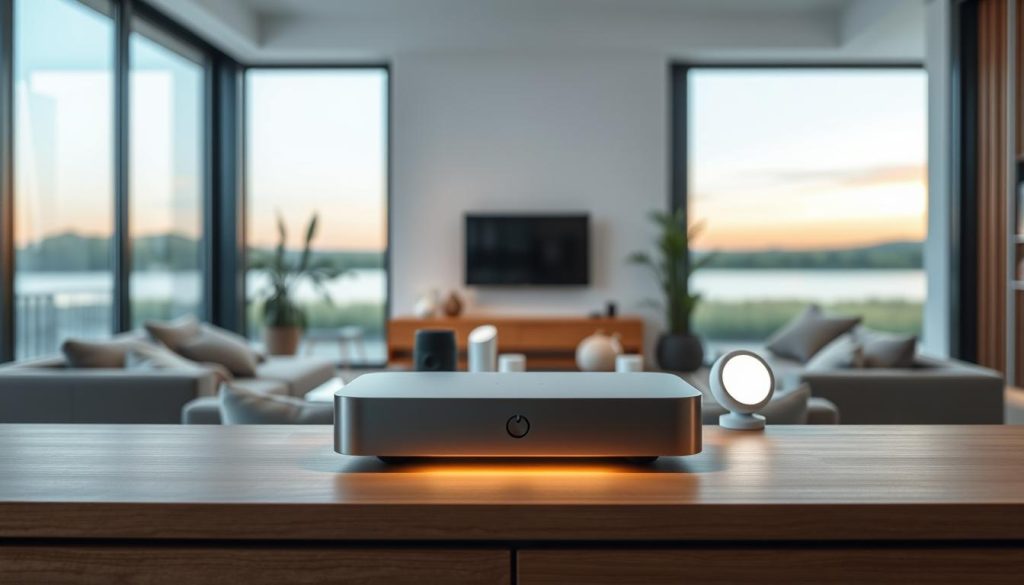
- Choose built‑in Wi‑Fi for simple remote control and fewer points of failure.
- Use a nearby hub for retrofit modules to preserve exterior keys and add app access.
- Place hubs where Wi‑Fi is strong and away from interference for fast, reliable responses.
- Secure remote access by enabling two‑factor authentication and strong passwords.
- Remember: always‑connected Wi‑Fi uses more battery than local Bluetooth models.
| Setup | Best when | Notes |
|---|---|---|
| Built‑in Wi‑Fi | You want direct app control | Fewer hops, more power use |
| Hub / bridge | Retrofit or limited external support | Requires placement and power |
| Matter‑enabled device | Cross‑platform flexibility | Works across major smart home systems |
Installation and door fit: how to get a pro‑grade fit with a screwdriver
A tidy install starts with a few measurements and a steady Phillips screwdriver. Most deadbolt swaps take about 10–15 minutes when you follow the steps and keep parts organized.
Measure door thickness and backset before you buy. Most kits fit common doors (1⅜”–2¼”) and include shims or adapters for a snug fit.
Align the latch and strike so the bolt moves freely. Test the bolt mechanically by closing the door and turning the thumb turn before you add batteries or finalize pairing.
- Mark screw holes with a pencil and use masking tape to avoid scratches.
- Keep old hardware until the return window closes in case you need to revert.
- Use the app‑guided setup for pairing, calibration, and code creation to make the whole process easy and quick.
| Step | Why it matters | Result |
|---|---|---|
| Measure door & backset | Ensures fit | Avoids extra parts |
| Align latch & strike | Prevents binding | Smooth bolt throw |
| Test mechanical action | Verify fit before power | Less rework |
Battery life, power backups, and alerts you can trust
Battery planning is the quiet maintenance task that keeps your lock ready when you need it most.
Most smart lock models run for months on AA cells under normal household use. Built‑in Wi‑Fi and heavy traffic shorten that span, and retrofit modules with rechargeable packs tend to need more frequent charging.
Enable app notifications so low‑battery warnings reach you early. Many apps send timely alerts and show remaining life so you can swap cells before the next expected outing.
- Expect several months from AA‑powered units; continuous Wi‑Fi cuts runtime.
- Look for emergency power options: 9V touchpoints or power‑reserve modes that let you unlock with a phone or temporary external power.
- Reduce motor strain by adjusting auto‑lock timing and ensuring a smooth bolt throw.
- Keep spare cells or a charged pack on hand and schedule seasonal checks.
- Turn on activity alerts so the app confirms each lock unlock and flags anomalies you should investigate.
Best picks by use case: renters, homeowners, Airbnb hosts
Match your entry tech to how you live and who uses your door most.
Renters benefit from retrofit modules that preserve exterior hardware and avoid landlord changes. Choose an interior adapter or an adhesive keypad to add keyless entry and scheduling without swapping cylinders.
Homeowners should favor full deadbolt replacements for the main front door when strong hardware and built‑in Wi‑Fi matter most. These bring higher durability, built‑in alarms, and broad platform support for remote access.
Airbnb hosts need hassle‑free turnover: issue time‑bound codes, review activity logs, and rotate credentials between stays. Keypad‑first options keep guests from downloading apps and simplify check‑in.
- Keep exterior keys intact with retrofits if required by a lease or aesthetic concerns.
- Use levers for side or garage doors where code access is preferred but a deadbolt isn’t needed.
- Match features to use: quiet motors for late arrivals, many code slots for frequent guest changes, and tamper alerts for peace of mind.
| Use case | Recommended option | Why it fits |
|---|---|---|
| Renter | Retrofit adapter / adhesive keypad | Preserves exterior hardware; quick install |
| Homeowner | Full deadbolt replacement | Stronger hardware; built‑in remote access |
| Airbnb host | Keypad-first or high-code models | Time codes, logs, no app for guests |
Budget vs premium: where to spend for security and ease of use
Deciding between budget and premium options boils down to how you use the lock and what daily conveniences matter most.
If you want strong basics for less, models like Ultraloq give fingerprint access, good weather resistance, and solid app features without a steep price. That makes them sensible for side doors, rentals, or secondary entrances.
If daily comfort matters more, premium devices add Home Key-style phone unlocks, faster mechanics, and top-tier build quality. Level Lock Pro and similar flagship devices improve responsiveness and reduce fuss at the main entry.
Also weigh total cost of ownership: battery swaps, hubs or bridges, and optional subscriptions for video or cloud services add up. A smart strategy is a flagship deadbolt on the primary door and retrofits for secondary doors.
- Choose biometrics when quick, keyless access matters; prefer a keypad when battery life and guest simplicity matter more.
- Balance device reliability against price to cut support calls and guest friction.
| Budget | Premium | Best use |
|---|---|---|
| Ultraloq: fingerprint, IP65 | Level Lock Pro: Matter, fast actuation | Secondary vs primary entry |
| Lower upfront cost | Higher convenience, longer life | Weigh long‑term costs |
Beyond the big three: noteworthy alternatives in 2025
Some devices hide their tech in plain sight, while others put video and biometrics front and center for easier access control.
Level Lock Pro gives a minimal, near‑invisible look and adds Matter plus Home Key for seamless phone access. If you want a clean front‑door view, it keeps hardware subtle while joining modern ecosystems.
Lockly Visage packs face recognition, fingerprint, and a dynamic keypad. Choose it when you value multiple unlock modes and can accept a higher price and a rechargeable pack.
- Eufy Video Smart Lock E330 combines 2K video, keypad, and fingerprint for single‑device visibility and entry control.
- ULTRALOQ Bolt NFC supports Home Key and fits Apple‑centric setups on a budget.
- Kwikset and Schlage Connect give Z‑Wave models for hub‑centric homes that want deep automation with existing systems.
| Model | Key features | Best fit |
|---|---|---|
| Level Lock Pro | Matter, Home Key, invisible design | Minimalist smart home |
| Lockly Visage | Face + fingerprint + dynamic keypad | Biometric-first entries |
| Eufy E330 | 2K video, onboard storage, fingerprint | Single-device video & access |
Pick based on the mix you value most—biometrics, minimal design, or integrated video—and how each device fits your home and app ecosystem.
Reality check on hacking, privacy, and safe app practices
Practical privacy and app habits matter more than fear when you secure a connected lock. Communications from reputable devices are encrypted, so remote breaches are rare. Most break‑ins exploit unlocked doors or open windows, not a hacked device.
Follow a few simple habits to harden your system. Use strong, unique passwords and enable two‑factor authentication for the app and cloud account. Avoid weak PINs like 1234 and rotate guest codes after use.
- Disable voice unlock or use it cautiously to avoid shoulder‑surfing and spoken codes.
- Respond to low‑battery alerts and keep spare cells or a charged pack ready to prevent lockouts.
- Limit data sharing in privacy settings and install firmware updates promptly to patch vulnerabilities.
| Risk | Mitigation | Why it helps |
|---|---|---|
| Unlocked entry | Auto‑lock + alerts | Stops crimes of convenience |
| Account takeover | Strong password + 2FA | Protects cloud and app access |
| Guest access | Separate admin & guest roles | Least privilege, quick revocation |
These steps keep your home safer and make your smart locks and lock hardware perform as intended. Small practices often beat complex fixes.
Conclusion
Wrap up your decision by focusing on practical features that improve daily access and dependability.
You now know how to match a smart lock to your door, ecosystem, and priorities without overpaying for unused extras. Pick a rugged built‑in Wi‑Fi deadbolt for primary entrances, a compact keypad model for quiet, multi‑platform support, or a retrofit adapter when you want to keep keys.
Plan installs, manage batteries, and enable clear alerts and codes so the lock performs reliably. Consider alternatives—minimalist designs, biometrics, or video‑integrated options—based on your front‑door needs and your long‑term view of convenience and protection.
Schlage, Yale, and August are solid reference points, and several niche models fill specific gaps so you can choose with confidence.
